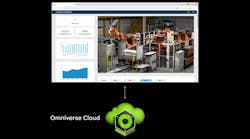Check out Electronic Design's coverage of GTC 2024.
What you’ll learn:
- Insight into NVIDIA’s Omniverse Cloud APIs.
- Their integration into existing software packages.
- Potential applications for the platform.
NVIDIA announced the expansion of its Omniverse Cloud APIs (application programming interfaces) for industrial digital-twin (virtual models of physical objects) applications and software developers. Utilizing those APIs, developers can seamlessly integrate core Omniverse technologies into their existing software applications, enabling efficient workflows for digital twins and simulation processes, including those for autonomous vehicles and robotics.
Omniverse serves as a metaverse for developers and engineers to conceptualize and generate 3D models. Those digital twins can act and react within that platform using hyperrealistic physical simulations of real-world objects, meaning developers can see how their creations will react in any given environment.
Omniverse Cloud Creates a Collaborative Design Environment
The Omniverse Cloud becomes a platform-as-a-service for developing generative-AI-enabled OpenUSD applications. It provides a collaborative environment where designs can be shared freely with other users and team members on any given project, increasing efficiency and productivity.
“Everything manufactured will have digital twins,” stated Jensen Huang, founder and CEO of NVIDIA. “Omniverse is the operating system for building and operating physically realistic digital twins. Omniverse and generative AI are the foundational technologies to digitalize the $50 trillion heavy industries market.”
At the recent GTC 2024 developer conference, NVIDIA unveiled five new Omniverse Cloud APIs that can be used individually or collectively. They’re designed to aid in the seamless integration of applications and workflows for enhanced interoperability. This is done using OpenUSD, which provides a robust format for describing 3D animated scenes, similar to those in live-action films and visual effects productions. The five new APIs include:
- USD Render: Generates fully ray-traced NVIDIA RTX renders of OpenUSD data.
- USD Write: Lets users modify and interact with OpenUSD data.
- USD Query: Enables scene queries and interactive scenarios.
- USD Notify: Tracks USD changes and provides updates.
- Omniverse Channel: Connects users, tools, and worlds to enable collaboration across scenes.
By leveraging these APIs, developers can create dynamic “windows” from their applications directly into the Omniverse Cloud, thus seamlessly integrating metaverse scenes and digital twins within a software environment.
NVIDIA Building Partnerships with Top Tech Firms
NVIDIA has already signed an agreement with Apple to introduce Omniverse Cloud APIs to the Apple Vision Pro to stream 3D USD scenes to NVIDIA’s Graphics Delivery Network (GDN) graphics-ready data centers. The company has also partnered with other tech giants to bring their technologies to the forefront of innovation, including Siemens, which is adopting the Omniverse Cloud APIs for its Teamcenter X product lifecycle-management software.
Moreover, Ansys, a leader in engineering simulation software, is taking advantage of the Omniverse Cloud APIs for a number of its solutions, including Ansys AVxcelerate for autonomous vehicles, Ansys Perceive EM for 6G simulation, and Ansys Fluent. Cadence, a computational software provider, has followed suit as well—it’s tasked NVIDIA’s APIs with its Reality Digital Twin Platform, which allows users to design, simulate, and optimize data centers. What’s more, Dassault Systèmes is integrating the Omniverse Cloud APIs and Shutterstock 3D AI Services to drive generative AI storytelling in its 3DEXCITE applications for content creation.
The Rise of Digital Twins
NVIDIA’s decision to release the Omniverse Cloud APIs reflects a broader movement toward the adoption of digital twins in a number of industries. This allows companies to streamline the development of digital twins and integrate the platform within existing software packages.
In turn, the platform ushers in a new wave of innovation in many industries, including manufacturing to provide increased efficiency and product quality; the energy sector for optimizing power grids and enhancing predictive maintenance; and construction for advanced building designs and virtual tours.
The release of the Omniverse Cloud APIs marks a significant advance in the development and deployment of digital twins. Their user-friendly integration, flexibility, and adaptability will make them an ideal solution for numerous applications in the years to come.
